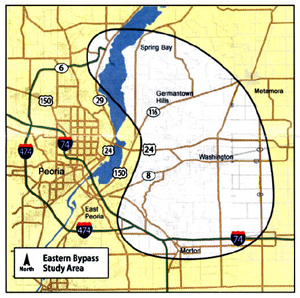This past Wednesday, July 16, I attended the public meeting/open house on the Sheridan Triangle Roadway Enhancement project. All the project team members were in attendance:
- Scott Reeise, City of Peoria representative
- Eric Bachman, Farnsworth Group project manager
- Keith Covington, Third Coast Design urban designer
- Lee Jones, Third Coast Design urban designer
- George Ghareeb, Terra Engineering public coordinator
- Phil Allyn, Farnsworth Group traffic engineer
- Bruce Brown, Farnsworth Group landscape/streetscape architect
Second district councilmember Barbara Van Auken was also there to kick things off and introduce everyone. Unfortunately, not a lot of residents or business owners were in attendance — maybe ten at the most. I’m not sure when the immediate neighbors were notified of the meeting, but I heard about it on Wednesday in the early afternoon. If others were notified that late, it’s no wonder it wasn’t better attended.
Nevertheless, the material presented was very encouraging. The plan that’s coming together is almost exactly what the neighbors and business owners who attended the Farrell/Madden charrette in 2006 said they wanted. Here are the materials that were distributed:
 Sheridan Triangle Flyer
Sheridan Triangle Flyer
 Sheridan Triangle PowerPoint Slides
Sheridan Triangle PowerPoint Slides
 Sheridan Triangle Alternatives B and C
Sheridan Triangle Alternatives B and C
In past, non-public meetings, there were other options put forth, including one for a roundabout at the intersection of Loucks, Gift, and Sheridan. Now, everything has been narrowed down to two alternatives, which were presented in detail at the meeting. After the meeting, participants filled out questionnaires asking which alternative they preferred, as well as other questions about what they liked and didn’t like about each alternative.
I tried out the video function of my new digital camera that night and was able to capture five minutes of the presentation. (I decided to do this just on a whim, so I didn’t have a tripod with me. Thus, if you’re prone to seasickness, you may not want to watch this video — not the steadiest shot. I could only get five minutes because I only have a 1GB memory card, and I had other pictures on it already. Also, I added a plugin to my site so that I can play videos directly from the Chronicle without having to go through YouTube!) The speaker is Keith Covington. He’s just finished explaining that the only difference between alternatives B and C is the treatment of the Sheridan/Loucks/Gift intersection:
[flashvideo filename=http://peoriachronicle.com/wp-content/uploads/Video/Keith_Covington.flv /]
I prefer alternative C. It will do the best job of calming traffic, and is the least disruptive to existing businesses. It provides a beautiful terminus for Loucks when traveling from either direction. And it’s more pedestrian friendly, since two streets will be at right angles at the intersection, providing shorter crosswalks. From talking to other attendees after the event, it sounds like that’s what they preferred as well.
In all cases, the plans took into account a balanced use of the corridor. Sidewalks are wider. Street trees, pedestrian-scale lighting, and on-street parking provide a buffer between motor vehicle and pedestrian/bicycle traffic. Bus pull-offs and shelters are provided. It’s consistent with the Heart of Peoria Plan and the Form Based Code.
Kudos to the project team and all who have been working to improve this area. Hopefully this project will be fully funded when the budget is set for the next fiscal year.

 In the city’s “Issues Update” this week, there was information regarding the upcoming Eastern Bypass study. This is the plan to connect Route 6 and I-474 on the east side of the river, making a ring road — a complete bypass for the greater Peoria area. Here’s the letter IDOT Deputy Director of Highways Joe Crowe wrote to Pekin Mayor Dave Tebben (emphasis mine):
In the city’s “Issues Update” this week, there was information regarding the upcoming Eastern Bypass study. This is the plan to connect Route 6 and I-474 on the east side of the river, making a ring road — a complete bypass for the greater Peoria area. Here’s the letter IDOT Deputy Director of Highways Joe Crowe wrote to Pekin Mayor Dave Tebben (emphasis mine):